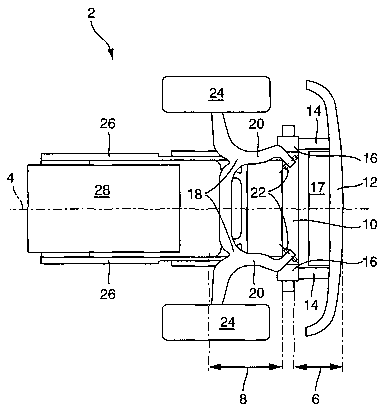Une partie des informations de ce site Web a été fournie par des sources externes. Le gouvernement du Canada n'assume aucune responsabilité concernant la précision, l'actualité ou la fiabilité des informations fournies par les sources externes. Les utilisateurs qui désirent employer cette information devraient consulter directement la source des informations. Le contenu fourni par les sources externes n'est pas assujetti aux exigences sur les langues officielles, la protection des renseignements personnels et l'accessibilité.
L'apparition de différences dans le texte et l'image des Revendications et de l'Abrégé dépend du moment auquel le document est publié. Les textes des Revendications et de l'Abrégé sont affichés :
| (12) Demande de brevet: | (11) CA 2616050 |
|---|---|
| (54) Titre français: | STRUCTURE AVANT DE VEHICULE UTILITAIRE |
| (54) Titre anglais: | FRONT-END VEHICLE STRUCTURE FOR A COMMERCIAL VEHICLE |
| Statut: | Réputée abandonnée et au-delà du délai pour le rétablissement - en attente de la réponse à l’avis de communication rejetée |
| (51) Classification internationale des brevets (CIB): |
|
|---|---|
| (72) Inventeurs : |
|
| (73) Titulaires : |
|
| (71) Demandeurs : |
|
| (74) Agent: | KIRBY EADES GALE BAKER |
| (74) Co-agent: | |
| (45) Délivré: | |
| (86) Date de dépôt PCT: | 2006-07-12 |
| (87) Mise à la disponibilité du public: | 2007-02-01 |
| Licence disponible: | S.O. |
| Cédé au domaine public: | S.O. |
| (25) Langue des documents déposés: | Anglais |
| Traité de coopération en matière de brevets (PCT): | Oui |
|---|---|
| (86) Numéro de la demande PCT: | PCT/EP2006/006799 |
| (87) Numéro de publication internationale PCT: | EP2006006799 |
| (85) Entrée nationale: | 2008-01-21 |
| (30) Données de priorité de la demande: | ||||||
|---|---|---|---|---|---|---|
|
L'invention concerne une structure avant (2) de véhicule utilitaire, cette structure comprenant, dans le sens longitudinal (4) du véhicule, une zone d'impact avant (6) et une zone d'impact arrière (8). La zone d'impact avant (6) et la zone d'impact arrière (8) sont mutuellement reliées par une structure intermédiaire (10) intercalée dans l'espace et s'étendant sensiblement transversalement au sens longitudinal (4) du véhicule, de sorte qu'une force pénétrant dans la zone d'impact avant (6) est transmise à la zone d'impact arrière (8) par la structure intermédiaire (10).
The invention relates to a front-end vehicle structure (2) for a commercial
vehicle, comprising a forward crash zone (6) and a rear crash zone (8)
relative to the longitudinal direction (4) of the vehicle. The forward crash
zone (6) and the rear crash zone (8) are interconnected via an intermediate
structure (10) which is mounted therebetween and extends substantially
perpendicular to the longitudinal direction (4) of the vehicle such that a
force that is applied to the forward crash zone (6) can be transmitted to the
rear crash zone (8) via the intermediate structure (10).
Note : Les revendications sont présentées dans la langue officielle dans laquelle elles ont été soumises.
Note : Les descriptions sont présentées dans la langue officielle dans laquelle elles ont été soumises.

2024-08-01 : Dans le cadre de la transition vers les Brevets de nouvelle génération (BNG), la base de données sur les brevets canadiens (BDBC) contient désormais un Historique d'événement plus détaillé, qui reproduit le Journal des événements de notre nouvelle solution interne.
Veuillez noter que les événements débutant par « Inactive : » se réfèrent à des événements qui ne sont plus utilisés dans notre nouvelle solution interne.
Pour une meilleure compréhension de l'état de la demande ou brevet qui figure sur cette page, la rubrique Mise en garde , et les descriptions de Brevet , Historique d'événement , Taxes périodiques et Historique des paiements devraient être consultées.
| Description | Date |
|---|---|
| Demande non rétablie avant l'échéance | 2010-07-12 |
| Le délai pour l'annulation est expiré | 2010-07-12 |
| Réputée abandonnée - omission de répondre à un avis sur les taxes pour le maintien en état | 2009-07-13 |
| Lettre envoyée | 2008-10-30 |
| Inactive : Déclaration des droits - Formalités | 2008-05-12 |
| Inactive : Décl. droits/transfert dem. - Formalités | 2008-04-15 |
| Inactive : Page couverture publiée | 2008-04-14 |
| Inactive : Notice - Entrée phase nat. - Pas de RE | 2008-04-10 |
| Inactive : CIB en 1re position | 2008-02-12 |
| Demande reçue - PCT | 2008-02-11 |
| Exigences pour l'entrée dans la phase nationale - jugée conforme | 2008-01-21 |
| Demande publiée (accessible au public) | 2007-02-01 |
| Date d'abandonnement | Raison | Date de rétablissement |
|---|---|---|
| 2009-07-13 |
Le dernier paiement a été reçu le 2008-06-19
Avis : Si le paiement en totalité n'a pas été reçu au plus tard à la date indiquée, une taxe supplémentaire peut être imposée, soit une des taxes suivantes :
Les taxes sur les brevets sont ajustées au 1er janvier de chaque année. Les montants ci-dessus sont les montants actuels s'ils sont reçus au plus tard le 31 décembre de l'année en cours.
Veuillez vous référer à la page web des
taxes sur les brevets
de l'OPIC pour voir tous les montants actuels des taxes.
| Type de taxes | Anniversaire | Échéance | Date payée |
|---|---|---|---|
| Taxe nationale de base - générale | 2008-01-21 | ||
| TM (demande, 2e anniv.) - générale | 02 | 2008-07-14 | 2008-06-19 |
| Enregistrement d'un document | 2008-09-02 |
Les titulaires actuels et antérieures au dossier sont affichés en ordre alphabétique.
| Titulaires actuels au dossier |
|---|
| DAIMLER AG |
| Titulaires antérieures au dossier |
|---|
| MARIO LIST |
| WOLFGANG PEDROTTI |